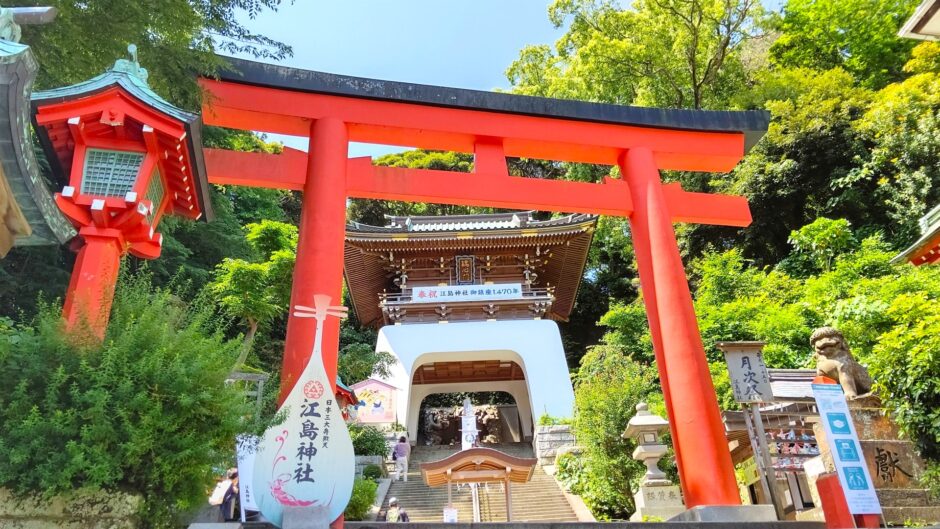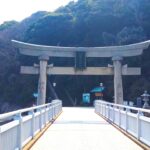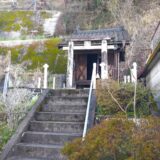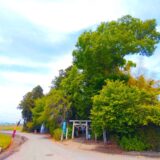目次
- 【Enoshima Shrine summary】
- 【Enoshima Bridge】
- 【Enoshima Shrine bronze torii】
- 【Enoshima Shrine Hetsu-miya】
- 【Enoshima Shrine Nakatsu-miya】
- 【Enoshima Shrine Okutsu-miya】
- 【Enoshima Shrine Chigo-ga-fuchi (Children’s Pond)】
- 【Enoshima Daishi】
- 【Enoshima Shrine GOSHUIN】
- 【Enoshima Shrine Access】
- Manager’s Comments
- Enoshima Shrine
【Enoshima Shrine summary】
Enoshima Shrine was founded in 1206. The entire island of Enoshima is sacred territory, and it is one of the three major Benzaiten shrines in Japan. The shrine is composed of three shrines, Hetsumiya, Nakatsumiya, and Okutsumiya, each enshrining one of the three Munakata Goddesses. The three Munakata Goddesses are Tagitsuhime no Mikoto, Takiribime no Mikoto, and Ichikishimahime no Mikoto, who were born out of the mist created by Amaterasu’s bite of Susanoo’s sword. They are the children of Susanoo because they were born from Susanoo’s fruit.
Together with Yaotomi Shrine, Chikubushima, and Itsukushima, it is one of the Seven Benten Temples of Japan.
【Enoshima Bridge】
![Enoshima Shrine [Kanagawa] DSC 0254 1 1024x768 - Enoshima Shrine [Kanagawa]](https://japan-shrine.info/wp-content/uploads/DSC_0254-1-1024x768.jpg)
The Enoshima Bridge was completed in 1962 as a construction road for the construction of Shonan Port, which will be the site of the 1964 Tokyo Olympics. The bridge connects the mainland of Fujisawa City with Enoshima Island for vehicles (cars and bicycles) and is the entrance to Enoshima. The bridge is 786 meters long, and its piers are made of concrete. The “Enoshima Benten Bridge,” a pedestrian bridge, runs parallel to it on the west side. Especially during sunset (especially on the west side), the bridge is popular among couples as a perfect sunset spot because there is nothing to obstruct the view.
【Enoshima Shrine bronze torii】
![Enoshima Shrine [Kanagawa] 29956997 m 1024x683 - Enoshima Shrine [Kanagawa]](https://japan-shrine.info/wp-content/uploads/29956997_m-1024x683.jpg)
The torii gate at the entrance to Enoshima, built in 1747, was rebuilt in 1821 by many donors in its present bronze form. After passing through the bronze torii gate and passing through the Nakamise, you will see the Otorii, which was donated in 1936. In front of the vermilion torii gate and up a flight of stone steps is the Zuishinmon Gate, a tower gate modeled after a dragon palace. It is said that the gate was made to resemble the Dragon’s Palace, with the intention of encouraging visitors to pass through the gate with a pure heart.
【Enoshima Shrine Hetsu-miya】
![Enoshima Shrine [Kanagawa] DSC 0232 1024x768 - Enoshima Shrine [Kanagawa]](https://japan-shrine.info/wp-content/uploads/DSC_0232-1024x768.jpg)
Hengu Shrine enshrines the deity Tagitsuhime no Mikoto (Princess Manabu). Because of its location at the bottom of Enoshima, which has a difference in elevation, the shrine was called “Shimonomiya” until the Meiji era (1868-1912).
【Enoshima Shrine Nakatsu-miya】
![Enoshima Shrine [Kanagawa] DSC 0236 1 1024x768 - Enoshima Shrine [Kanagawa]](https://japan-shrine.info/wp-content/uploads/DSC_0236-1-1024x768.jpg)
The shrine is dedicated to Ichisunshimahiru-no-mikoto, the most beautiful of the three sisters, and is said to bring blessings for the improvement of the arts, monetary fortune, and beauty. The shrine pavilion is very brightly colored in vermilion, and is decorated with colored carvings of dragons, pine trees, turtles, etc. All of them are beautiful. The shrine pavilions are all beautiful.
【Enoshima Shrine Okutsu-miya】
![Enoshima Shrine [Kanagawa] DSC 0241 1 1024x768 - Enoshima Shrine [Kanagawa]](https://japan-shrine.info/wp-content/uploads/DSC_0241-1-1024x768.jpg)
Takirihiru-no-Mikoto is the eldest of the three sisters and is said to be the deity who protects the sea in peace. Okutsumiya, the closest shrine to Iwaya, the birthplace of the dragon god legend, was once called Otabisho, and the main shrine of Iwaya Hongu was relocated during the period from April to October, when seawater entered the main shrine of Iwaya. The main shrine, located beyond the worship hall, is said to have been built in the Heian period (794-1185). Because it was destroyed by fire, it was rebuilt in the late Edo period and renovated in the mid-Heisei period.
【Enoshima Shrine Chigo-ga-fuchi (Children’s Pond)】
![Enoshima Shrine [Kanagawa] DSC 0245 1024x768 - Enoshima Shrine [Kanagawa]](https://japan-shrine.info/wp-content/uploads/DSC_0245-1024x768.jpg)
This beach is located on the opposite side of Enoshima Island. Wakanigafuchi is a sea-eroded plateau created by an uplift phenomenon, and is located directly below the cliffs that resemble a folding screen. It is known for the beauty of the crashing waves and the sunset over Mt. Fuji, and has been selected as one of the “50 Scenic Spots of Kanagawa. It is made of unique rocks and has tide pools. Be careful not to fall into the sea, as you will be swept away.
【Enoshima Daishi】
![Enoshima Shrine [Kanagawa] DSC 0238 1 1024x768 - Enoshima Shrine [Kanagawa]](https://japan-shrine.info/wp-content/uploads/DSC_0238-1-1024x768.jpg)
Enoshima Daishi was built in 1993 on the site of the Enoshima-kan ryokan (Japanese inn), which closed down in 1964. Two red Kongorikishi (Niou) statues are enshrined at the entrance to Enoshima Daishi. The main hall is a modern building, but the Sorin extending from the center of the roof indicates that it is a temple. The main deity is Fudo Myoo. It is located on the way from Henzumiya to Okutsumiya, but is unrelated to Iwamotoin Temple, which was originally the Eshima Daimyojin Shrine.
【Enoshima Shrine GOSHUIN】
![Enoshima Shrine [Kanagawa] 2023 07 01 23 24 Office Lens 665x1024 - Enoshima Shrine [Kanagawa]](https://japan-shrine.info/wp-content/uploads/2023_07_01-23_24-Office-Lens-665x1024.jpg)
![Enoshima Shrine [Kanagawa] 2024 09 29 20 03 Office Lens 712x1024 - Enoshima Shrine [Kanagawa]](https://japan-shrine.info/wp-content/uploads/2024_09_29-20_03-Office-Lens-712x1024.jpg)
Enoshima Shrine’s red seal book is made of cedar wood and is my favorite because of its fragrance. It is branded “Enoshima.”
【Enoshima Shrine Access】
Manager’s Comments
Eshima is a familiar place on Japanese news programs’ weather reports. It is so well known that many tourists visit the area throughout the year. The Nakamise Street leading to Eshima Shrine is a popular place for tourists to store for seafood and octopus crackers, and there are many new stores as well as stores that have not changed over the years. In the summer, the shrine is very popular with tourists for beach trips, dates, and sightseeing, and although it can be a bit lonely to visit the shrine alone as a man, there is much to see and do in the shrine’s history, making it a place you will want to visit again and again.
 Tour of Japanese shrines and temples
Tour of Japanese shrines and temples 


![Enoshima Shrine [Kanagawa] DSC 1723 520x300 - Enoshima Shrine [Kanagawa]](https://japan-shrine.info/wp-content/uploads/DSC_1723-520x300.jpg)
![Enoshima Shrine [Kanagawa] 9ef036b73922f137116c1348bfb8a8ea - Enoshima Shrine [Kanagawa]](https://japan-shrine.info/wp-content/uploads/sng/9ef036b73922f137116c1348bfb8a8ea.jpg)

![Enoshima Shrine [Kanagawa] DSC 0082 1 150x150 - Enoshima Shrine [Kanagawa]](https://japan-shrine.info/wp-content/uploads/DSC_0082-1-150x150.jpg)
![Enoshima Shrine [Kanagawa] DSC 0851 2 150x150 - Enoshima Shrine [Kanagawa]](https://japan-shrine.info/wp-content/uploads/DSC_0851_2-150x150.jpg)
![Enoshima Shrine [Kanagawa] sumiyoshitaisha jp2 150x150 - Enoshima Shrine [Kanagawa]](https://japan-shrine.info/wp-content/uploads/sumiyoshitaisha-jp2-150x150.jpg)

